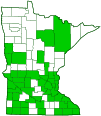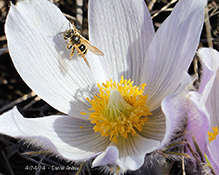ligated furrow bee
(Halictus ligatus)
Conservation • Description • Habitat • Ecology • Distribution • Taxonomy
|
|
||||||||||||||
Description |
Ligated furrow bee is a very common, medium-sized, ground-nesting, eusocial bee. It occurs in the United States, Mexico, Central America, northern South America, and southern Canada. In the United States it occurs in each of the lower 48 states. It is common in the southern half of Minnesota, uncommon to absent in the north. It is found in a wide variety of habitats, especially in sandy areas. Adults are generalist feeders and can be found on a very wide variety of flowers. The female is 5⁄16″ to ⅜″ (8 to 10 mm) in length. The head and body are entirely black with pale hairs and without a greenish cast. The head is much wider than long and appears thick. The compound eyes are parallel. On the face there is just a single line-like groove extending downward from the base of each antenna (subantennal suture). The cheeks are much wider than the eyes and are strongly hooked with a prominent knob-like projection at the base. The tongue is short. The small plates (tegulae) covering the wing bases are coppery. Each abdominal segment (tergum) has a band of whitish hairs at the bottom (apically). This feature distinguishes the genus Halictus from the closely related genus Lasioglossum, which has bands at the top (basally). The bands on the first two terga are narrow and inconspicuous, the remaining bands are distinct. The wings are mostly translucent with yellowish veins and a yellowish cell (stigma) on the leading edge (costal margin) just before the marginal cell. The marginal cell is pointed but not sharply pointed. There are three submarginal cells. The first cell is longer than the third. The veins dividing the submarginal cells are dark and prominent. The basal vein is strongly arced at the base, like the letter J. The male is smaller, ¼″ to ⅜″ (7 to 9 mm) in length. The head is as wide as long. The compound eyes converge slightly at the bottom. The cheeks are not as wide as the eyes. The legs are black at the base. The fourth leg segment (tibia) is brownish-gray on the underside, yellowish on the upper side. |
Size |
Female: 5⁄16″ to ⅜″ (8 to 10 mm) Male: ¼″ to ⅜″ (7 to 9 mm) |
Similar Species |
Habitat |
A wide variety of habitats, especially sandy areas |
Ecology |
Season |
Several overlapping generations per year: early spring to autumn |
Behavior |
Sometimes large numbers build their nests close together. |
Life Cycle |
A young, hibernating, reproductive female (gyne) emerges in the spring. She builds a nest in the ground consisting of an 8″ to 3′ deep vertical tunnel with many short side tunnels. She lays a single egg in each side tunnel, provisions it with pollen, then seals the tunnel. The nest has a mound of dirt surrounding the entrance and looks like an ant hill. |
Larva Food |
Flower pollen |
Adult Food |
Flower nectar and pollen |
Distribution |
||
|
Sources |
|
| 4/27/2024 | ||
Occurrence |
||
Very common, locally abundant |
||
Taxonomy |
|
Order |
Hymenoptera (Ants, Bees, Wasps, and Sawflies) |
Suborder |
Apocrita (Narrow-waisted Wasps, Ants, and Bees) |
Infraorder |
Aculeata (Ants, Bees, and Stinging Wasps) |
Superfamily |
Apoidea (Bees and Apoid Wasps) |
Epifamily |
|
Family |
Halictidae (sweat bees) |
Subfamily |
|
Tribe |
Halictini |
Genus |
Halictus (furrow bees) |
Subgenus |
Odontalictus |
Halictus ligatus is probably a species complex that will be split into multiple species in the future. |
|
Subordinate Taxa |
|
|
|
Synonyms |
|
|
|
Common Names |
|
ligated furrow bee ligated gregarious sweat bee |
|
Glossary
Costal margin
The leading edge of the forewing of insects.
Stigma
In plants, the portion of the female part of the flower that is receptive to pollen. In Lepidoptera, an area of specialized scent scales on the forewing of some skippers, hairstreaks, and moths. In other insects, a thickened, dark, or opaque cell on the leading edge of the wing.
Tegula
A small, hardened, plate, scale, or flap-like structure that overlaps the base of the forewing of insects in the orders Lepidoptera, Hymenoptera, Diptera, and Homoptera. Plural: tegulae.
Tergum
The upper (dorsal) surface of a body segment of an arthropod. Plural: terga.
Tibia
The fourth segment of an insect leg, after the femur and before the tarsus (foot). The fifth segment of a spider leg or palp. Plural: tibiae.
Tubercle
On plants and animals: a small, rounded, raised projection on the surface. On insects and spiders: a low, small, usually rounded, knob-like projection. On slugs: raised areas of skin between grooves covering the body.
Visitor Photos |
||
Share your photo of this insect. |
||
This button not working for you? |
||
Dan W. Andree |
||
 |
||
Small Bee or Wasp on American Pasque Flower… Seen small bees or some kind of small wasps feeding on pasque flower blossoms at Frenchman’s Bluff SNA. This was one I seen. It was pretty dry in spots out there but noticed other prairie vegetation starting to poke out of the ground. Rain is expected for the next 2-3 days so that should help further along growth. |
Here is another photo of that small bee or... small wasp. It was maybe half an inch long. The pasque flower blossom shown was fairly large for a pasque flower. |
|
Alfredo Colon |
||
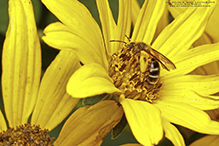 |
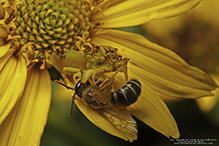 |
|
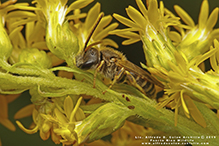 |
||
Mike Poeppe |
||
 |
||
MinnesotaSeasons.com Photos |
||
|
||
|
||

Slideshows |
|

Visitor Videos |
||
Share your video of this insect. |
||
This button not working for you? |
||
|
Other Videos |
||
Halictus ligatus on Helianthus |
About
May 30, 2017 PIRU, Logan, UT |
LIGATED FURROW BEE, Halictus ligatus foraging |
About
Jan 13, 2020 LIGATED FURROW BEE, Halictus ligatus foraging. Horner Park, Chicago 8/27/2019 |

Visitor Sightings |
||
Report a sighting of this insect. |
||
This button not working for you? |
||
| Mike Poeppe 6/10/2022 |
Location: Just west of Houston, MN |
 |
| Alfredo Colon 8/10/2019 |
Location: Woodbury, Minnesota |
 |
| Alfredo Colon 8/8/2019 |
Location: Woodbury, Minnesota |
 |
| Alfredo Colon 8/6/2019 |
Location: Woodbury, Minnesota |
 |
MinnesotaSeasons.com Sightings |
||
|

Created: 7/14/2022 Last Updated: © MinnesotaSeasons.com. All rights reserved. |
